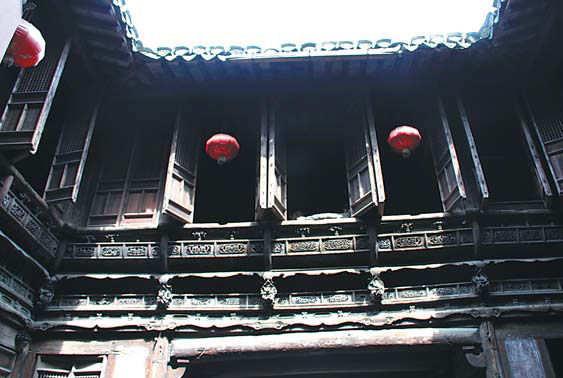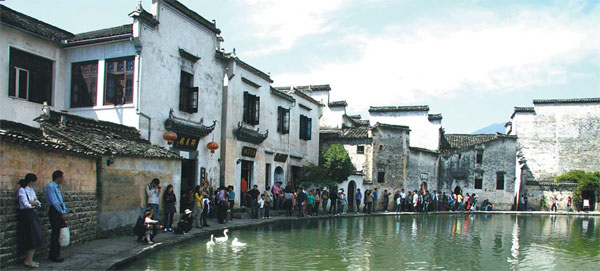USTC lab builds new defense for ancient Chinese buildings

With growing tourism industry creating hazards for old sites, scientists create new fireproof measures, Zhu Lixin reports.
With ancient towns and villages in China gaining in popularity among tourists, experts at the University of Science and Technology of China have developed measures to protect buildings within these ancient sites from fire hazards.
Wang Jian, a scientist at the State Key Laboratory of Fire Science at USTC, based in Hefei, Anhui province, said many ancient buildings are susceptible to fire, though preventative measures have improved greatly.
| Wang Jian, a scientist from USTC, conducts fireproof research in Hongcun village in southern Anhui province. |
| Ancient Chinese buildings, most of them composed of wood, are highly susceptible to fire hazards. |
Fire disasters have occurred more frequently in ancient buildings in recent years. From 2009 to 2014, more than 1,300 fires broke out in China's ancient buildings, according to data released by the country's public security and cultural relics protection authorities last year.
Wang said many of the ancient buildings have been overexploited for tourism purposes, making them more prone to fires.
Wang, 55, has been working at the fire science lab in USTC for more than two decades and is experienced in fire disaster research.
As the only State key lab focusing on science and technology related to fire disasters in China, SKLFS has several departments focusing on certain types of fire disasters.
"Improving an ancient building's fire safety measures is not an easy task," said Wang.
The difficulty partly comes from the fact that most ancient Chinese buildings are wooden and brick structures.
"Such wooden structures as pillars and beams bear most of the weight of the buildings, while bricks were mostly used for separation walls," Wang said.
As a result, once a fire breaks out, it may easily lead to a big disaster.

On January 2014, a major fire burned down 242 ancient buildings in the 1,300-year-old ancient town of Shangri-La county in Yunnan province.
At the end of the year, another fire destroyed 60 Miao ethnic residential buildings that were more than 600 years old in Jianhe county, Guizhou province.
Both of the disasters were reportedly caused by small accidents.
"Traditional ways to improve a building's resistance to fire include the installation of water spray devices, though such methods often do not work well for ancient buildings," said Wang, who added that local fire and cultural relics protection authorities often fail to agree on the use of such devices.
Cultural relics authorities worry that the large amount of water from spray devices may bring irrevocable losses to cultural relics, Wang said.
Wang's latest research focuses on a famous ancient village in Anhui province, where ancient towns and villages play an important role in the local tourism industry.
The Hongcun case
The village Wang's team is trying to protect is Hongcun, which was added to the World Cultural Heritage list in 2000.
Located in Huangshan, Hongcun covers more than 19 hectares and has hundreds of ancient buildings, with the oldest more than 900 years old.
Official data shows that the village attracted more than 1.63 million tourists in 2014. That number is estimated to grow significantly this year.
"The more popular the village is among tourists, the more important it is to protect it from fires," said Wang.
"The reason why a fire can grow into such a large scale, in the cases of Yunnan and Guizhou, is that the buildings were built together and there is no separation between them," said Wang.
To avoid similar tragedies from befalling the old buildings in Hongcun, Wang proposed using a number of measures to prevent a fire from happening, including the installation of flame-resistant clapboard on the top of the buildings.
The most common and most effective method is to soak the timber in fire retardant liquid that is able to penetrate into the wood under high pressure. "But this is too expensive and can only be used when pillars or beams need to be replaced or repaired," Wang said.
After years of research, SKLFS has developed a fire retardant coating that is transparent and can be used for ornamental purposes. The material was invented by a team of scientists led by Hu Yuan, a senior scientist at the lab, and has since been widely used in ancient buildings.
Wang said the painting also has anticorrosion and mothproofing functions and does not alter a building's appearance. He said the measure can help prevent a fire from spreading too quickly, leaving enough time for firefighters to arrive at the site.
"If the material doesn't have good fire-resistance performance, a flashover, the most dangerous stage in the development of a fire, may take place soon, which means everything would be too late," Wang said.
Contact the writer through zhulixin@chinadaily.com.cn
Yan Beibei contributed to this story
| With hundreds of ancient buildings, the oldest of which are about 900 years old, Hongcun village in the city of Huangshan is a World Cultural Heritage site. Photos provided to China Daily |
(China Daily European Weekly 11/20/2015 page23)
Today's Top News
- Japan tempting fate if it interferes in the situation of Taiwan Strait
- Stable trade ties benefit China, US
- Experts advocate increasing scope of BRI to include soft power sectors
- New engine powers cargo drone expansion
- China to boost green industry cooperation
- Manufacturing PMI rises in November

































